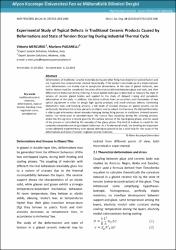Experimental Study of Typical Defects in Traditional Ceramic Products Caused by Deformations and State of Tension Occurring During Industrial Thermal Cycle
Abstract
Deformations of traditional ceramic materials during and after firing may depend on several factors and
are in general too complex to be studied theoretically. If the products are made up of a single material,
such deformations are mainly due to pyroplastic phenomena. In the case of glazed materials, two
further factors must be considered: the state of tension established between glaze and body, and their
differences in behaviour during sintering. A novel optical technique is described to measure the state of
tension of ceramic glazed bodies and applied to the study of delayed crazing and pyroplastic
deformation of the body. In addition, this article outlines how can ceramists avail themselves of new
optical equipment in order to design high quality products and avoid ordinary defects. Combining
dilatometric tests and bending analysis, a full study of residual stresses on glazed ceramic can be
performed, therefore this is how planarity problems can be solved. Furthermore the Optical Fleximeter
is able to get information about viscosity changing during firing process in traditional sintered ceramic
bodies, like stone-ware or porcelain-ware: the viscous flow occurring during the sintering process,
where the driving force is mainly given by the surface tension of the liquid glassy phase, and the speed
of the process is controlled by the viscosity of the glassy phase. This kind of analysis is crucial for the
complete comprehension of pyroplastic behaviour. As a fundamental result, the bending and expansion
curves obtained experimentally with optical techniques proved to be a valid help for the study of the
deformations and state of tension in glazed ceramic materials.
Source
Fen Bilimleri DergisiVolume
14Issue
Özel SayıCollections
- Cilt 14 : Sayı 3 [90]



















